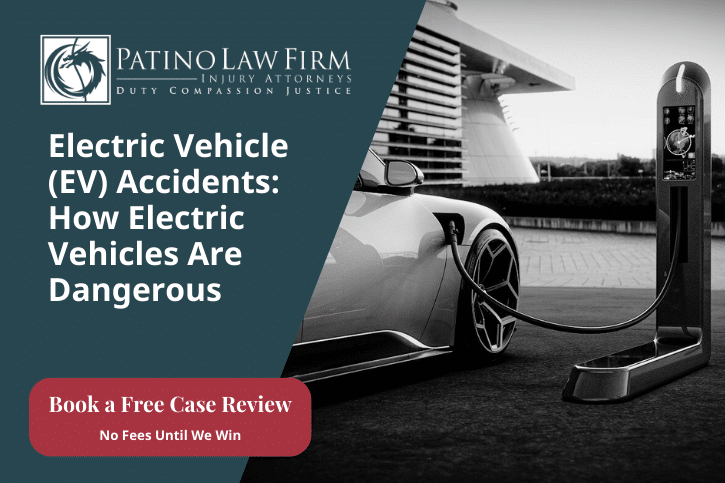Electric vehicles (EVs) are increasingly common, but with the undeniable environmental benefits of this technology come distinct safety concerns. In this blog post, McAllen and San Antonio personal injury attorney Dr. Louis Patino examines the dangers of EVs and how they contribute to electric vehicle accidents.
What Dangers Do Electric Vehicles Pose?
Any vehicle — gasoline or electric-powered — has the potential to cause a devastating crash, but there are several safety concerns unique to electric vehicles, including the following:
- Fires: EV batteries burn at extremely high temperatures, making battery fires a severe risk.
- Pedestrian safety: Electric vehicles are near-silent. While their quiet operation reduces noise pollution, it poses a hazard for pedestrians, especially those with impaired sight who rely on sound cues to cross the road.
- EV malfunctions: The novelty of this technology means there are many unknowns, and EVs — especially self-driving cars — are vulnerable to software glitches or features not functioning as intended. One such example is unintended acceleration, where the motor accelerates unexpectedly.
- The increased reliance on self-driving vehicles: The very nature of “self-driving” as a concept can cause motorists to become overly reliant on the technology and not be as vigilant on the road.
- Electrocution: Damaged high-voltage battery packs in EVs can pose an electrocution risk to first responders and those involved in an accident.
Electric Vehicle Accident Risks to Pedestrians
One of the most significant dangers of EVs is that they are virtually silent when in operation. Even at low speeds, a car can cause severe — if not fatal — damage to a pedestrian, who might not see an EV approaching until it’s too late, if at all. Add in the possibility of drivers being distracted, speeding, or driving under the influence, and the results can be even more devastating.
Given the potentially catastrophic impact of a silent EV striking a pedestrian, Congress passed the Pedestrian Safety Enhancement Act in 2010, requiring hybrid and electric vehicles to emit a sound when traveling under 18.6 miles per hour to alert pedestrians.
This law partially stemmed from a report published by the National Highway Traffic Safety Administration (NHTSA) in 2009. The agency found that hybrid EV accidents involving pedestrians increased by 40% compared to conventional vehicle accidents. The study included a small sample of accidents due to the rarity of EVs on the road.
A follow-up study in 2011 found the electric vehicle accident rate was 35% higher than gasoline-powered cars, primarily due to low-speed accidents. These studies are not perfect — the sites of these accidents were suburban or urban areas with a higher volume of pedestrians than rural roads and highways. Still, more recent studies show that EVs pose a substantial risk to pedestrians. A 2017 report by the U.S. Department of Transportation found the electric and hybrid vehicle accident rate involving pedestrians was 20% higher. That percentage increased to 50% for low-speed maneuvers like turning, reversing, slowing, and accelerating into traffic.
Burn Risks
Gas fires and explosions can be devastating, but electric vehicles are not automatically safer. Battery fires can be just as severe — if not more so — as they burn hotter and last longer.
In 2021, two men died when a Tesla Model S with Autopilot active failed to turn. The vehicle ran off the road, struck a tree, and set fire. Tragically, firefighters were unable to put out the flames. Despite blasting the fire with 30 thousand gallons of water, the battery continued to burn for four hours, and the fire department had no choice but to let the fire burn out.
A year later in Indiana, insurance company State Farm sued Tesla for $1.27 million when the car’s electrical system failed, starting a fire in the vehicle owner’s garage that spread to the attached home.
A fire can quickly break out if a battery is defective or the car’s charging system is faulty, but that’s not the only threat. Lithium-ion is the most commonly used material for EV batteries because they are lightweight and can store a lot of energy. However, if burned, they pose a grave health risk, releasing toxic fumes into the environment that motorists and pedestrians may inhale.
Glitches and Overreliance on ‘Autopilot’ Technology
There is still a lot we don’t know about electric vehicles, assisted driving technology, and the associated risks. This can result in frightening — not to mention life-threatening — scenarios. One example is sudden unintended acceleration, which happens when a malfunction in the vehicle’s electrical system fails to stabilize a voltage spike, causing the motor to accelerate independently — and unintentionally.
These dangers are more prevalent when motorists use automated assistance technology like Tesla’s Autopilot feature — or, more accurately, when drivers are overreliant on such technology.
Take adaptive cruise control, for example, which measures the distance to the vehicle ahead and adjusts its speed accordingly. However, such technology cannot detect a stopped car, so if a driver isn’t paying attention, they could cause an accident.
EV manufacturer Tesla has recalled tens of thousands of vehicles over recent years because of faults. In 2021, Tesla investigated reports of its forward-collision warning (FCW) system falsely activating automatic emergency braking (AEW) when there was no risk of collision.
In a separate recall in 2022, Tesla recalled 54 thousand electric vehicles after its self-driving software was rolling through stop signs.
Assisted driving technologies do not mean drivers can figuratively put their feet up and browse social media, watch a movie, or play a game. Drivers must be vigilant behind the wheel and ready at any point to take control of their vehicle. But time after time, we see reports of motorists getting injured and killed in electric vehicle crashes because they trust Autopilot will not — quite literally — steer them wrong.
Stranded on the Road
Another danger of electric vehicles is their limited range. Most electric cars can travel for around 100 miles before needing to be recharged; if an EV’s battery dies during a long trip, motorists can find themselves stranded without food, water, or shelter, particularly in remote areas with limited charging infrastructure.
For those driving an electric vehicle for the first time, a different mindset and approach is required compared to when driving a gas-powered car, especially when going long distances. Unlike traditional gas stations, charging stations may not be as readily available, and charging times can vary, so motorists must plan carefully.
Filing an EV Accident Claim
If you’ve been injured in an EV accident, you could be entitled to compensation. However, electric vehicle accident claims are complex, and as this is still a fairly new technology, there is a lack of long-standing legal precedent on the issue.
The standard rules of negligence apply, but these can be challenging to prove. If you’re a pedestrian injured by an electric vehicle because you did not hear it approaching, the driver’s insurance company may argue that you would have seen the car if you were paying more attention.
But the burden of proof isn’t just on drivers — manufacturers must ensure their vehicles are safe and work as intended. In Germany, a ban was passed to prohibit advertising the Autopilot function of electric vehicles because of the prevalence of self-driving crashes.
These problems exist closer to home, too: Arizona ordered a ban on the testing of driverless vehicles after an autonomous Uber killed a pedestrian — the car failed to sense the pedestrian crossing the street and did not engage the brakes.
Then, there was the death of Apple engineer Walter Huang, who died when his autonomous Tesla struck a concrete highway. Huang’s family filed a wrongful death suit, and the trial was set to begin when Tesla settled for an undisclosed amount days before opening statements.
In an EV lawsuit, the cause — and who is responsible — can be difficult to prove. Complex technology often turns into complex litigation, and we’ve seen this recently with a slew of Tesla claims. Several were decided in favor of the defendant despite people having been seriously injured or killed in accidents. Only recently, with Walter Huang’s case, did we see the tide turn in favor of plaintiffs when Tesla settled the case at the eleventh hour.
All of these factors underscore the need for expert legal representation. Recovering compensation after an electric vehicle accident can be tricky, but it is not impossible. As electric vehicles become more commonplace, safety standards will evolve, and it will become easier to hold negligent manufacturers and drivers responsible for their harmful actions.
If you or a loved one has been injured in an electric vehicle accident, our experienced car accident attorneys in San Antonio and McAllen can help you get the compensation you deserve. We are not afraid of battling big corporations and will fight to protect your rights and recover the losses you are owed. We offer a free, no-obligation case review so you can determine if you have a case, learn what to expect, and find out how much you might be entitled to.

